An Analysis of the Morphology Evolution of YG8 Cemented Carbide by Laser Ablation in the Liquid Phase
Abstract
:1. Introduction
2. Materials and Methods
2.1. Test Material
2.2. Test Equipment
3. Results and Discussion
3.1. Analysis of the Shape Evolution of the Laser Ablation Dot Texture in a Liquid-Phase Environment
- (1)
- Three-dimensional morphology of laser ablation dot texture in liquid-phase environment
- (2)
- Laser ablation of dot texture two-dimensional profiles in a liquid-phase environment
- (3)
- Dimensional changes of laser ablation dot texture in liquid-phase environments
- (4)
- Modeling the shape evolution of laser ablation dot texture in a liquid-phase environment
3.2. Analysis of the Taper of Ablation Dot Texture Craters in Liquid-Phase Environments
4. Conclusions
Author Contributions
Funding
Institutional Review Board Statement
Informed Consent Statement
Data Availability Statement
Acknowledgments
Conflicts of Interest
References
- Zhang, Z.; Lu, W.; He, Y.; Zhou, G. Research on optimal laser texture parameters about antifriction characteristics of cemented carbide surface. Int. J. Refract. Met. Hard Mater. 2019, 82, 287–296. [Google Scholar] [CrossRef]
- He, C.; Yang, S.; Zheng, M. Analysis of synergistic friction reduction effect on micro-textured cemented carbide surface by laser processing. Opt. Laser Technol. 2022, 155, 108343. [Google Scholar] [CrossRef]
- Tong, X.; Gou, Y.; Yu, S. Anti-wear and anti-friction performance of cemented carbide under the interaction of micro-circular texture preparation and geometric parameters. Mater. Sci. Eng. B 2021, 268, 115116. [Google Scholar] [CrossRef]
- Niu, Y.; Pang, X.; Yue, S.; Shangguan, B.; Zhang, Y. The friction and wear behavior of laser textured surfaces in non-conformal contact under starved lubrication. Wear 2021, 476, 203723. [Google Scholar] [CrossRef]
- Yang, Z.; Ji, P.; Zhang, Z.; Ju, Y.; Wang, Z.; Zhang, Q.; Wang, C.; Xu, W. Fundamental 3D simulation of the femtosecond laser ablation for cooling hole drilling on Ni and Fe based aero-engine components. Opt. Commun. 2020, 475, 126237. [Google Scholar] [CrossRef]
- Murzin, S.P.; Balyakin, V.B. Microstructuring the surface of silicon carbide ceramic by laser action for reducing friction losses in rolling bearings. Opt. Laser Technol. 2017, 88, 96–98. [Google Scholar] [CrossRef]
- Öztürk, E. FEM and statistical-based assessment of AISI-4140 dry hard turning using micro-textured insert. J. Manuf. Process. 2022, 81, 290–300. [Google Scholar] [CrossRef]
- Ahuir-Torres, J.I.; Arenas, M.A.; Perrie, W.; de Damborenea, J. Influence of laser parameters in surface texturing of Ti6Al4V and AA2024-T3 alloys. Opt. Lasers Eng. 2018, 103, 100–109. [Google Scholar] [CrossRef]
- Temmler, A.; Braun, K.; Uluz, E. Heat accumulation and surface roughness evolution in CO2 nanosecond laser ablation of quartz glass. Opt. Laser Technol. 2021, 144, 107426. [Google Scholar] [CrossRef]
- Wei, J.; Yuan, S.; Zhang, J.; Zhou, N.; Zhang, W.; Li, J.; An, W.; Gao, M.; Fu, Y. Removal mechanism of SiC/SiC composites by underwater femtosecond laser ablation. J. Eur. Ceram. Soc. 2022, 42, 5380–5390. [Google Scholar] [CrossRef]
- van der Linden, S.; Hagmeijer, R.; Römer, G. Picosecond pulsed underwater laser ablation of silicon and stainless steel: Comparing crater analysis methods and analysing dependence of crater characteristics on water layer thickness. Appl. Surf. Sci. 2020, 540, 148005. [Google Scholar] [CrossRef]
- Yu, X.; Jiang, L.; Luan, Q.; Cai, Y.; Song, Q.; Wang, B.; Liu, Z. Investigation of mechanism and surface morphology on the femtosecond laser ablation of silicon nitride under different auxiliary processing environments. Ceram. Int. 2023, 49, 13425–13434. [Google Scholar] [CrossRef]
- Zhou, J.; Huang, Y.-X.; Zhao, Y.-W.; Jiao, H.; Liu, Q.-Y.; Long, Y.-H. Study on water-assisted laser ablation mechanism based on water layer characteristics. Opt. Commun. 2019, 450, 112–121. [Google Scholar] [CrossRef]
- Pang, M.-H.; Zhai, S.-J.; Feng, Q.-G.; Zhang, Q.-C.; Ma, L.-J. Preparation and tribological properties of cemented carbide Surface texture by liquid-phase assisted laser. Tribology 2021, 42, 1001–1011. [Google Scholar]
- Zhu, Q.; Fan, P.; Li, N.; Carlson, T.; Cui, B.; Silvain, J.-F.; Hudgins, J.L.; Lu, Y.F. Femtosecond-laser sharp shaping of millimeter-scale geometries with vertical sidewalls. Int. J. Extreme Manuf. 2021, 3, 045001. [Google Scholar] [CrossRef]
- Zhang, N.; Yang, D.; Liu, G. Preparation of YG8 hard alloy surface groove weave and its friction reduction properties. Mech. Eng. Mater. 2020, 44, 38–41+56. [Google Scholar]
- Qian, Y.; Jiang, M.; Zhang, Z.; Huang, H.; Yan, J. On the transformation between micro-concave and micro-convex in nanosecond laser ablation of a Zr-based metallic glass. J. Manuf. Process. 2021, 68, 1114–1122. [Google Scholar] [CrossRef]
- Wang, X.S.; Xu, W.T.; Liu, L.; Zhang, Z.W.; Jin, M.F.; Kang, M. Magnetic-field-assisted fabrication of micro-convex domes using long pulse laser. Appl. Phys. A 2017, 123, 592. [Google Scholar] [CrossRef]
- Hua, X.J.; Zhang, J.L.; Xie, X.; Ping, G.F. Laser Concave/Convex Micro-Texture Process of GCr15 Bearing Steal Surface. Chin. J. Lasers 2019, 46, 94–100. [Google Scholar]
- Zhang, Y.; He, X.; Yu, G.; Li, S.; Tian, C.; Ning, W.; Zhang, Y. Dynamic evolution of keyhole during multi-pulse drilling with a millisecond laser on 304 stainless steel. Opt. Laser Technol. 2022, 152, 108151. [Google Scholar] [CrossRef]
- Zhao, W.; Yu, Z.; Hu, J. Numerical simulation and experimental analysis on nanosecond laser ablation of titanium alloy. J. Manuf. Process. 2023, 99, 138–151. [Google Scholar] [CrossRef]
- Li, Q.; Yang, L.; Hou, C.; Adeyemi, O.; Chen, C.; Wang, Y. Surface ablation properties and morphology evolution of K24 nickel based superalloy with femtosecond laser percussion drilling. Opt. Lasers Eng. 2019, 114, 22–30. [Google Scholar] [CrossRef]
- Fu, Y.H.; Liu, Q.X.; Ye, Y.X.; Hua, X.J.; Kang, Z.Y.; Fu, H. Research on laser surface micro texturing processing of single pulse intervals. Chin. J. Lasers 2015, 42, 1203005. [Google Scholar]
- Jing, X.; Wang, J.; Song, X.; Chen, Y.; Jaffery, S.H.I. A comparative investigation on micro-channel by using direct laser ablation and liquid-assisted laser ablation on zirconia. Ceram. Int. 2023, 49, 31871–31880. [Google Scholar] [CrossRef]
- Cai, S.; Xiong, W.; Wang, F.; Tao, Y.; Ming, X.; Sun, X.; Zeng, X. Expansion property of plasma plume for laser ablation of materials. J. Alloys Compd. 2018, 773, 1075–1088. [Google Scholar] [CrossRef]
- Rudenko, A.; Abou-Saleh, A.; Pigeon, F.; Mauclair, C.; Garrelie, F.; Stoian, R.; Colombier, J.P. High-frequency periodic patterns driven by non-radiative fields coupled with Marangoni convection instabilities on laser-excited metal surfaces. Acta Mater. 2020, 194, 93–105. [Google Scholar] [CrossRef]
- Liu, B.; Wang, C.; Mi, G. Simulation of the removal mechanism of thermo-oxidized layer and surface morphological evolution on TA15 alloy under nanosecond pulsed laser ablation by multiphase flow model. J. Manuf. Process. 2021, 69, 69–83. [Google Scholar] [CrossRef]
- Sharma, S.; Mandal, V.; Ramakrishna, S.A.; Ramkumar, J. Numerical simulation of melt pool oscillations and protuberance in pulsed laser micro melting of SS304 for surface texturing applications. J. Manuf. Process. 2019, 39, 282–294. [Google Scholar] [CrossRef]
- Chen, T.; Chen, X.; Liu, G.; Zhang, X.; Zhang, W. Research on the ablation mechanism and ablation threshold of CMC-SiCf/SiC by using dual-beam coupling nanosecond laser. Ceram. Int. 2022, 48, 24822–24839. [Google Scholar] [CrossRef]
- Qingliang, S.; Tiyuan, W.; Qiang, S.; Fang, Y.; Hejun, L.; Fu, M.W. Unraveling of the laser drilling of carbon/carbon composites: Ablation mechanisms, shape evolution, and damage evaluation. Int. J. Mach. Tools Manuf. 2023, 184, 103978. [Google Scholar] [CrossRef]
- Gu, Z.; He, Y.; Yang, J.; Fu, Y.; Ji, J.; Zhang, Y.; Li, J.; Liu, G. Dual-path micro-holes process for 0Cr17Ni7Al stainless steel thin plate with picosecond laser. J. Manuf. Process. 2023, 101, 1224–1233. [Google Scholar] [CrossRef]

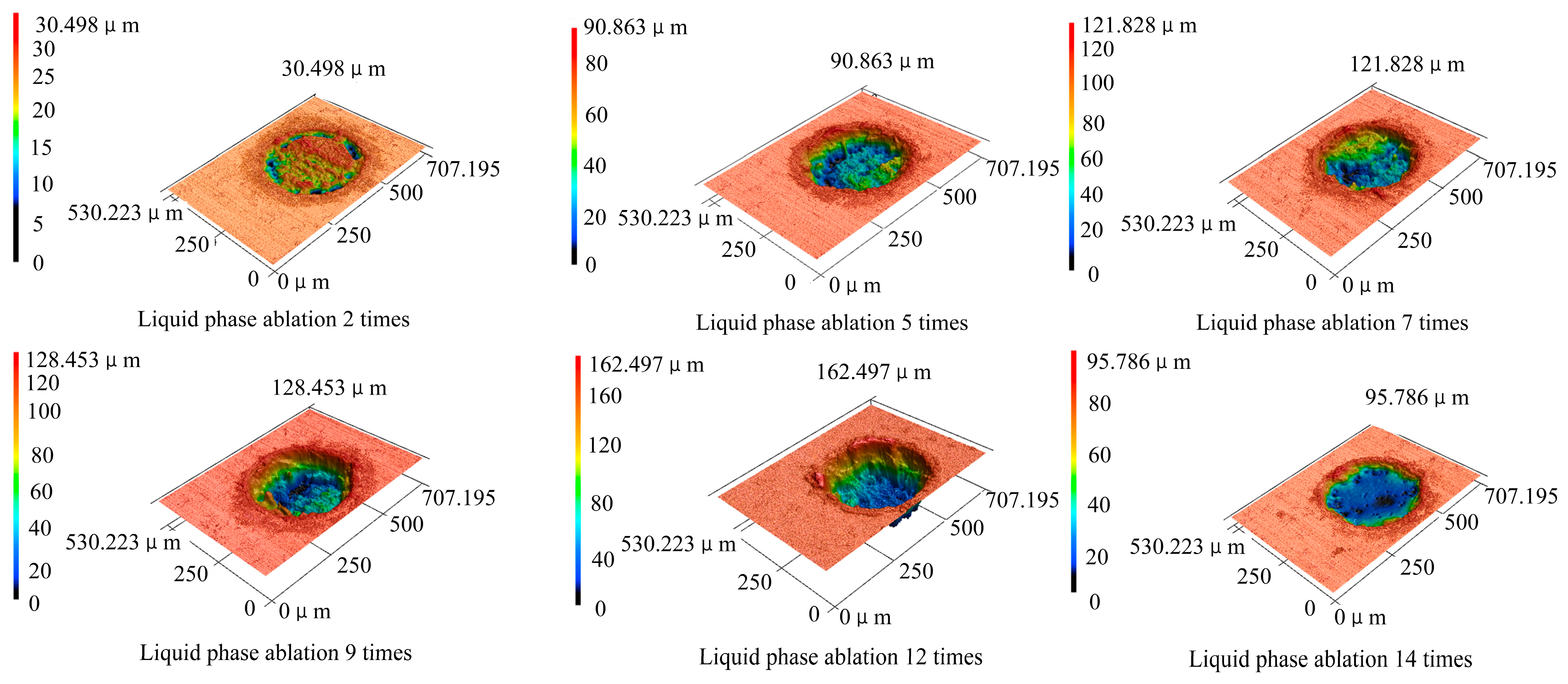

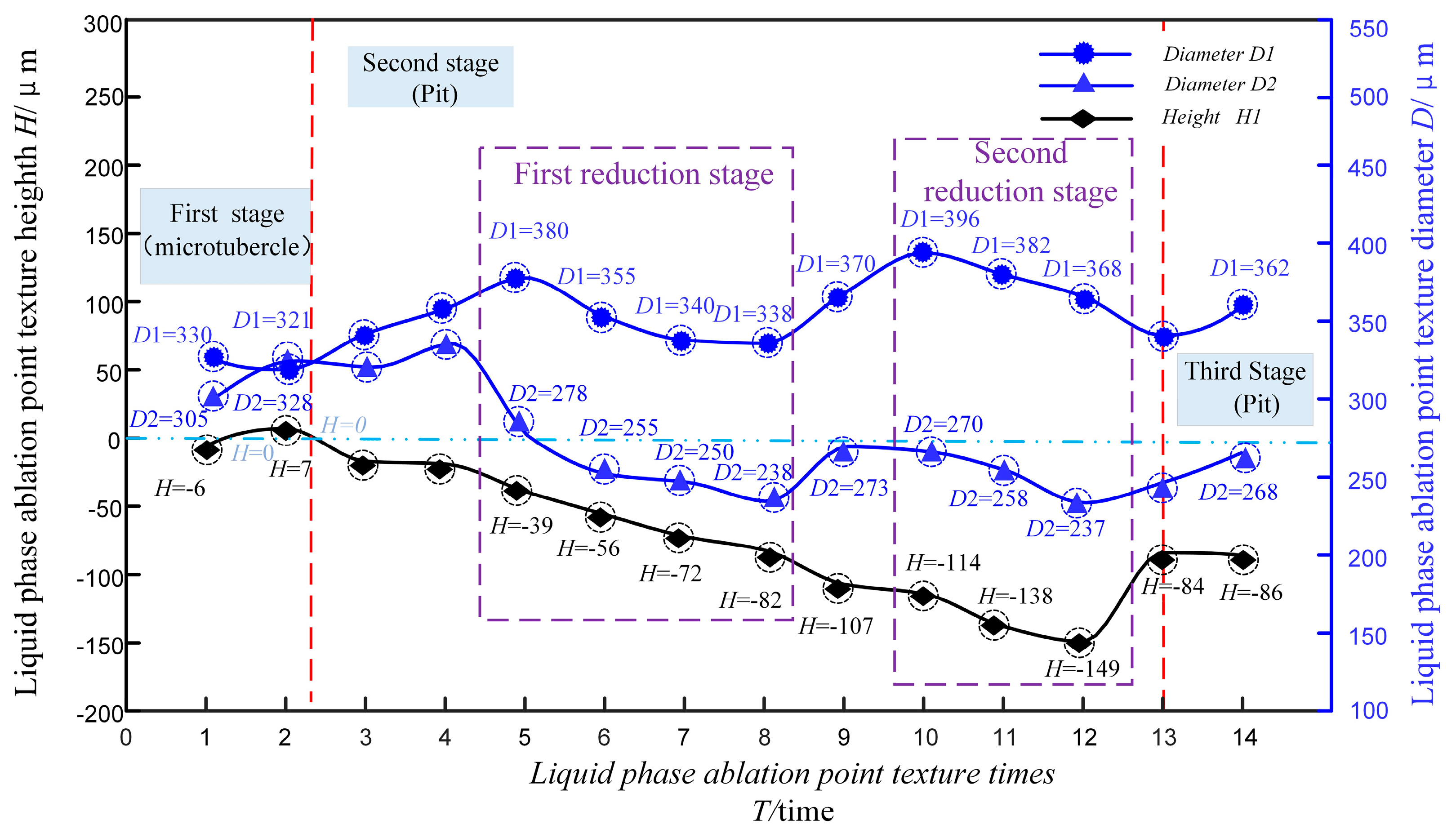
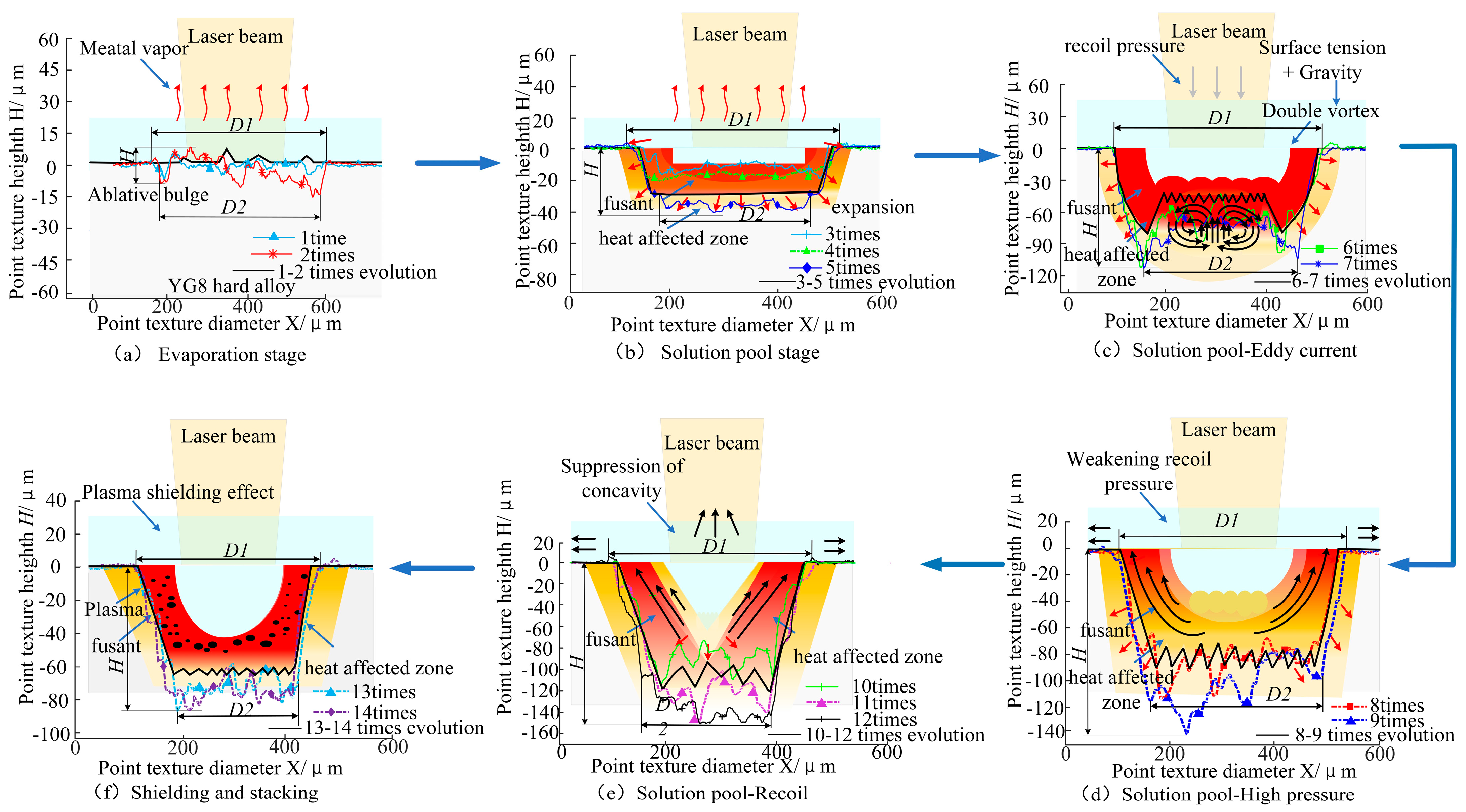
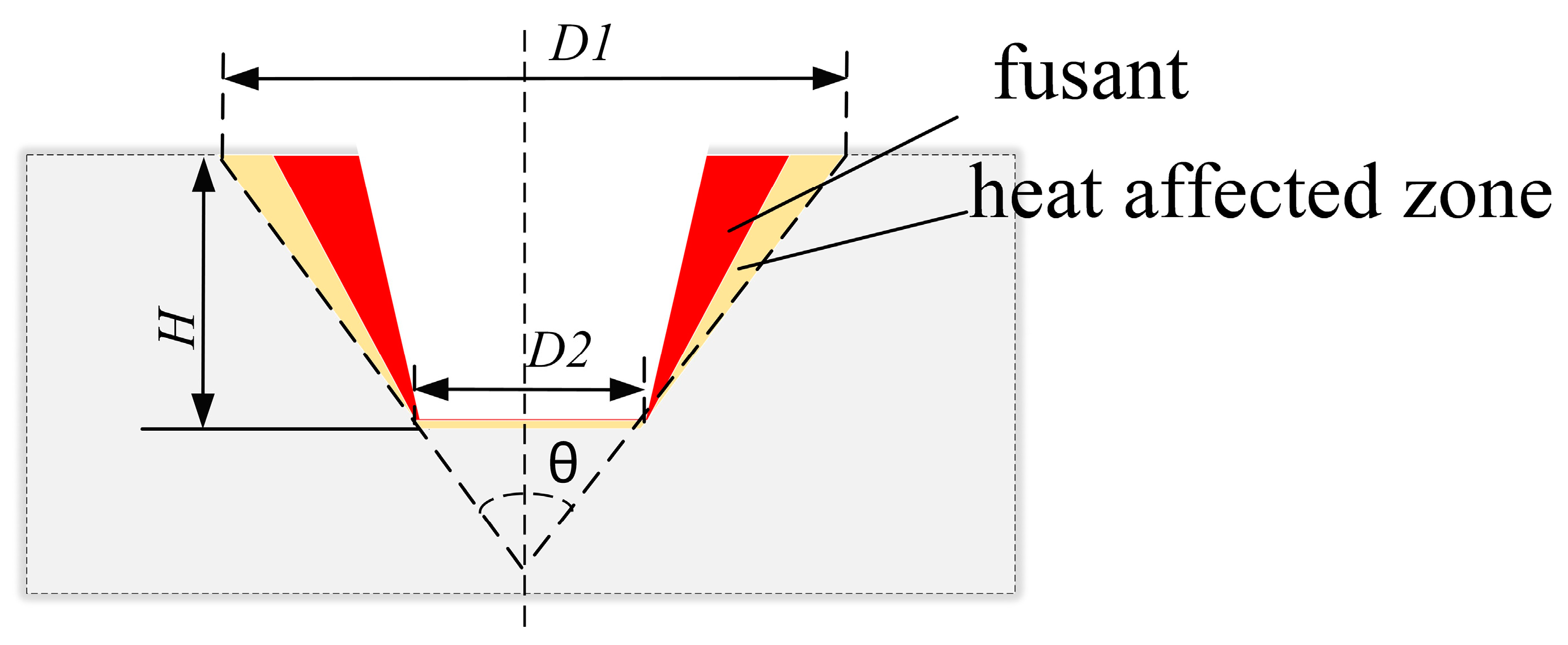
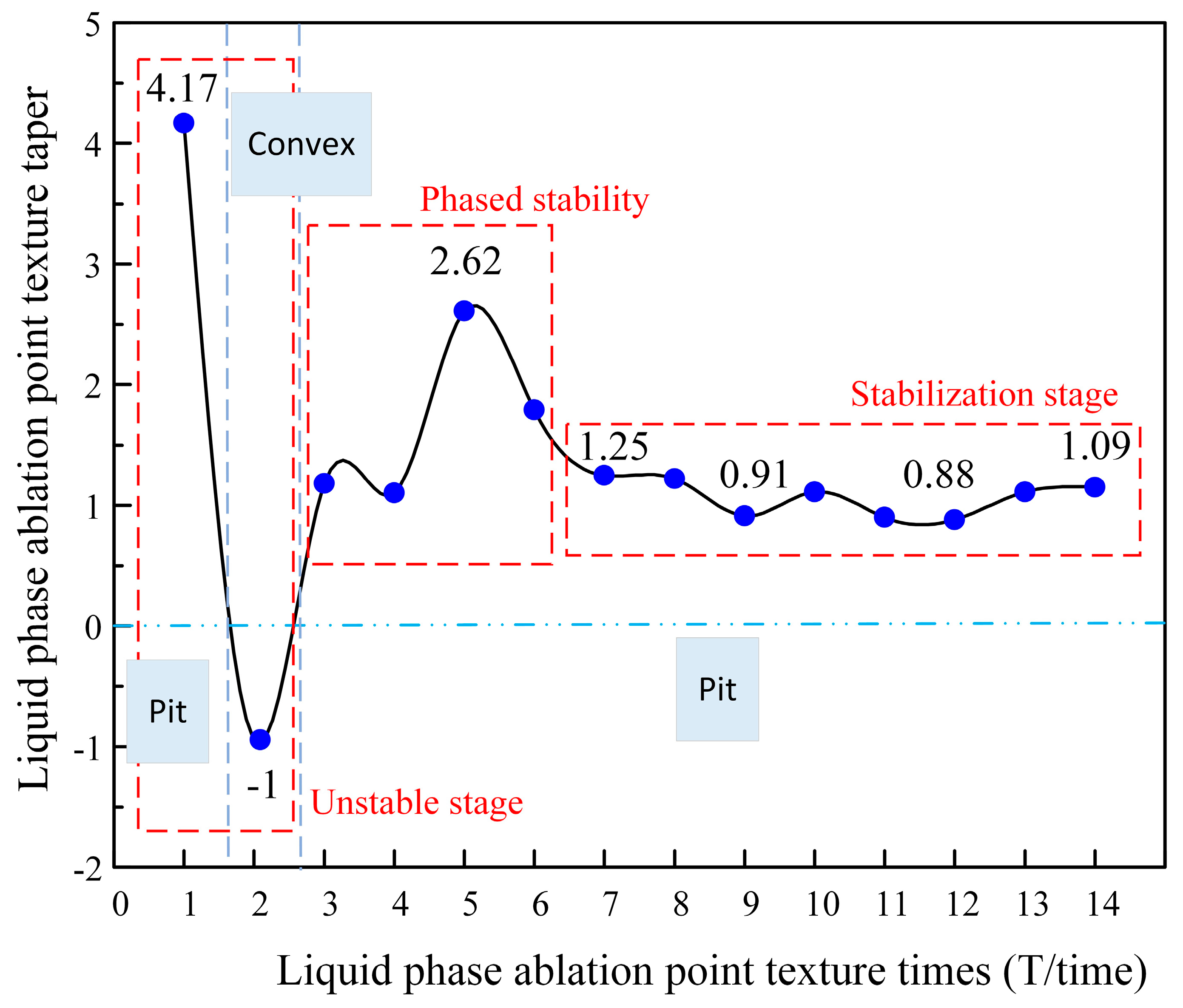
Disclaimer/Publisher’s Note: The statements, opinions and data contained in all publications are solely those of the individual author(s) and contributor(s) and not of MDPI and/or the editor(s). MDPI and/or the editor(s) disclaim responsibility for any injury to people or property resulting from any ideas, methods, instructions or products referred to in the content. |
© 2023 by the authors. Licensee MDPI, Basel, Switzerland. This article is an open access article distributed under the terms and conditions of the Creative Commons Attribution (CC BY) license (https://creativecommons.org/licenses/by/4.0/).
Share and Cite
Fan, Y.; Zhao, K.; Hao, M.; Xia, J.; Guan, X.; Liu, F. An Analysis of the Morphology Evolution of YG8 Cemented Carbide by Laser Ablation in the Liquid Phase. Coatings 2023, 13, 2061. https://doi.org/10.3390/coatings13122061
Fan Y, Zhao K, Hao M, Xia J, Guan X, Liu F. An Analysis of the Morphology Evolution of YG8 Cemented Carbide by Laser Ablation in the Liquid Phase. Coatings. 2023; 13(12):2061. https://doi.org/10.3390/coatings13122061
Chicago/Turabian StyleFan, Yujie, Kang Zhao, Mengjie Hao, Jing Xia, Xiaoyan Guan, and Fanghua Liu. 2023. "An Analysis of the Morphology Evolution of YG8 Cemented Carbide by Laser Ablation in the Liquid Phase" Coatings 13, no. 12: 2061. https://doi.org/10.3390/coatings13122061
APA StyleFan, Y., Zhao, K., Hao, M., Xia, J., Guan, X., & Liu, F. (2023). An Analysis of the Morphology Evolution of YG8 Cemented Carbide by Laser Ablation in the Liquid Phase. Coatings, 13(12), 2061. https://doi.org/10.3390/coatings13122061




